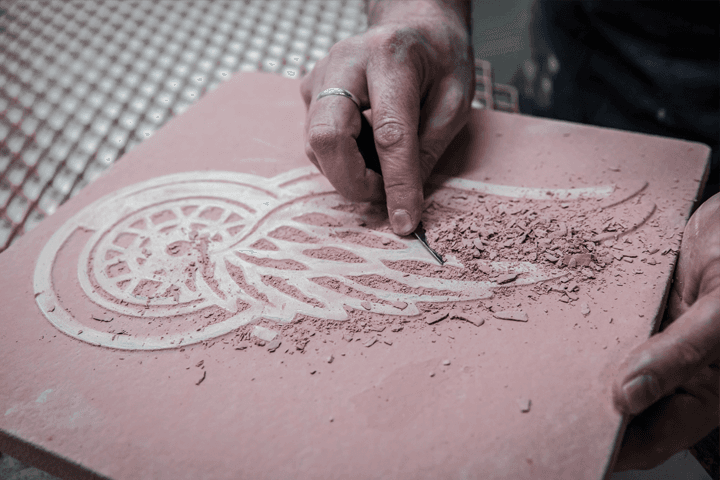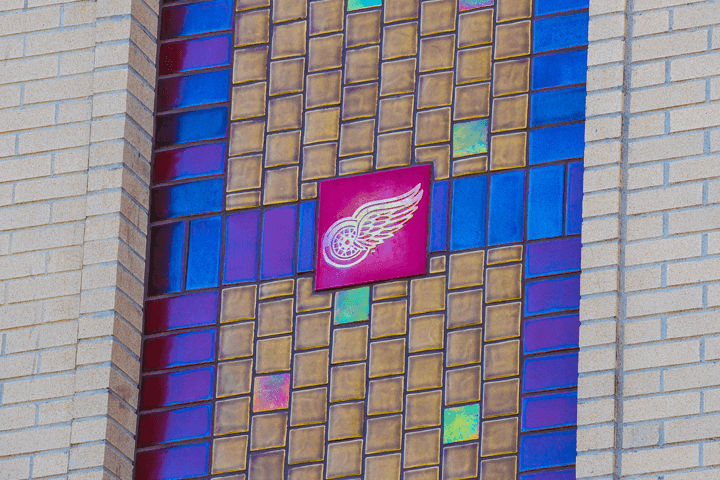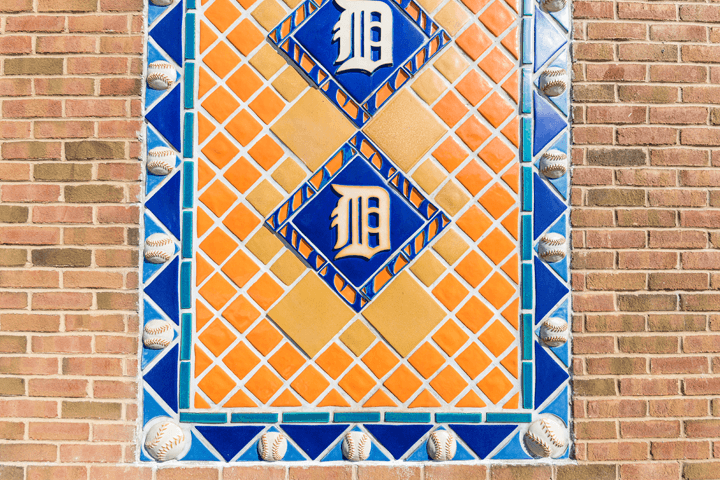Pewabic Design at Little Caesars Arena Part of Detroit’s Rich Cultural Legacy
When Little Caesars Arena debuted on Woodward Avenue in September, sports fans and concertgoers encountered many unique features, including a montage of hand-crafted tile cascading along the east side of the venue.
Pewabic, the historic pottery located in Detroit's Jefferson Corridor, designed and fashioned the 5,000-plus pieces that make up the exterior installation on Woodward Avenue. The 950-square-foot medley is made up of ceramic field tile and large Red Wings medallions.
“It’s like a link to the history of the city as we look forward,” said Pewabic Executive Director Steve McBride. “To be able to incorporate traditional craftsmanship into a very contemporary design that represents the future of the city is a neat metaphor for where Detroit is going.”
The independent nonprofit has operated out of its National Historic Landmark building since 1907, but it began in 1903 in a carriage house right across from the arena, in historic Brush Park. McBride said the name, derived from a Native American word meaning metal, foreshadowed the popular iridescent tile made by Pewabic artisans.
The east-side studio uses traditional techniques to mold clay and relies on the century-old mixer it used to fabricate the tile featured at the Detroit Institute of Arts, the Guardian Building, and more recently, the QLine streetcar stations.
By pressing and glazing the work by hand, the tile boasts subtle variations that stand out from ordinary tile. “You can feel the hand of the artist in every tile,” McBride said. “It makes the whole design feel deeper and richer; that’s where you see the difference in the tile produced here and a commercial manufacturer.”
The extensive process, which spanned four months for the Little Caesars project, included multiple firings in a natural gas kiln and the application of a special stain and oxides.
“Pewabic is a unique cultural asset that Detroit has and we are still contributing to this beautiful architectural design throughout the city,” McBride said of the contemporary pottery.
Genevieve Sylvia, the Special Projects Senior Designer at Pewabic, worked with the Ilitch organization and Detroit-based architectural firm, Hamilton Anderson Associates, to produce the arena’s Pewabic design. In 1999, she led the company’s contribution at Comerica Park, which features a more animated design engulfed by a three-dimensional baseball border.
Collaborators, she said, simplified the Little Caesars Arena design over time but did so in a way to preserve the Pewabic brand.
“It had to stand alone and not be a mimic of Comerica Park,” Sylvia said.
Fans can purchase 4x4 Red Wings gift tile similar to the Pewabic Red Wings ensigns featured on the arena’s exterior east side at the Team Store or through the Pewabic Store by calling 313-626-2010 or visiting 10125 E Jefferson Ave Monday-Saturday, 10 a.m.- 6 p.m. and Sunday noon-4 p.m. The royalty fees from sales will be donated to the Detroit Red Wings Foundation.
About The District Detroit
The District Detroit is one of the largest sports and entertainment developments in the country. Located in the heart of Detroit, this 50-block, mixed-use development led by the Ilitch organization unites eight world-class theaters, five neighborhoods and three professional sports venues in one vibrant, walkable destination for people who want to live, work and play in an exciting urban environment. Home to the Detroit Tigers, Detroit Red Wings, Detroit Pistons and Detroit Lions - The District Detroit represents the greatest density of professional sports teams in one downtown core in the country.
Current data from the University of Michigan demonstrates that The District Detroit will account for an economic impact of more than $2 billion by 2020 and create more than 20,000 construction and construction-related jobs and 3,000 permanent jobs.




